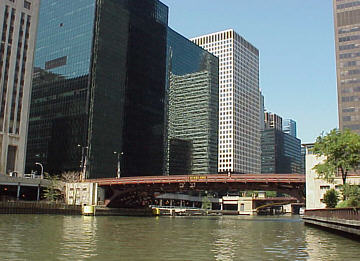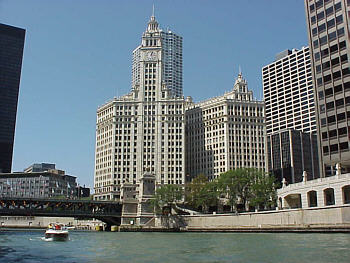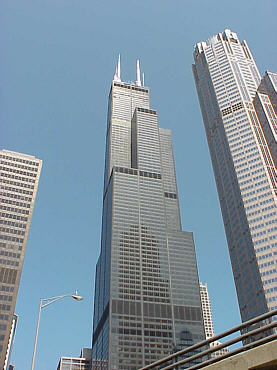|
My plan had been to make the loop with the wives on Saturday and then Sunday head on south. We were facing 10 locks in the process of getting home and I had made a guess that we would need four days on the river. I really didn't have to be back in the office on Thursday but there were a couple of items that would work out better if I were. As we were making our way down the 30 miles to the intersection at the 303.5 mile marker I started thinking about what I had sought to accomplish with this trip. I really wanted to run all the way from Lake Michigan to our homeport on the Kaskaskia River in Therapy. Now it appeared I would not be able to do this. The more I thought about it the more I wanted to complete my original goal. As we approached the junction of the two rivers I decided the heck with the office - I came to boat this river and I was going to do it! The older I become the more I realize that very few things in life are truly urgent. Often it is far more important to enjoy the moment rather than rushing on to the next perceived pressing problem. Well, maybe……. You see, there was a problem and it wasn’t the office. (What is it with me and these trips. I always seem to find myself in some type of "situation" right off the bat!). Because we had planned to take the wives on the loop around Chicago I had only filled one tank to keep the weight down. I thought when we completed the ride I would top off both tanks for the run south.
My 2000 addition of Quimby's only listed one marina with gas between us and the lake - Windy City Marina (on the chart it is called Marina City Marina). The problem was while on the water taxi ride I had noticed a marina with a sign that stated "Gas No Longer Available." Was that Windy City? If so does that mean that there is no fuel between here and the lake? I ran the numbers several times and it keep coming back the same - we didn't have enough gas to make the lake and then back downstream to the closest marina. Now what? The smart choice would be to dump my goal and head south, so obviously I decided to head north to the lake. I rationalize that we will go upstream to the point where we still have enough fuel to turn around and make the marina. If we find fuel by then great! If we don't we can sulk away in defeat but at least we tried. As we make the turn heading towards the downtown area we are now on the Chicago Sanitary & Ship Canal. This is a very narrow channel that was cut through solid limestone in some places and lined with stone blocks in others to form its shoreline. Because I live more or less downstream of Chicago I find the history of this canal very interesting. By the mid 1860s Chicago had grown to a large city. As with every city of any size there is always a problem of disposing of large volumes of human waste. Until that point everything was allowed to just flow into the rivers and on to Lake Michigan where it was diluted by the huge quantities of lake water. But during the last half of the century the death rates from cholera and typhoid fever drastically increased. The problem was linked to the very polluted water along the shores of the lake.
But it was not the last. In 1910 another channel was cut using the North Chicago River to divert the waste from the northern sections of the city. In 1922 the Cal-Sag Channel was added to drain the southern sections of waste. The Des Plaines and Illinois River had become Chicago's sewer ditch. This continued until 1930 when the courts forced the city to start building treatment plants. Today the channels and canals no longer are floating with untreated waste - well almost. But more on that later. In fact, the canal now is somewhat scenic. The vertical stonewalls that form its sides rise only a few feet above the water and are lined with trees. Although from the water many areas appeared undeveloped, there were considerable commercial enterprises in other spots. These grew in number the further we progress up the river and the picturesque stonewalls gave way to riprap. I have to add that there was a downside to all of this.
I need to qualify my complaint as it is coming from a person that has lived
his entire life in a small (pop. 2200) rural community - but both my passenger
and I agreed - this place stunk! I don't think the odor was coming
from the water but from the various factories along the shore. And it didn't
seem to be one odor but an ever-changing blend of "ode de pew". I
will say as we left the industrial area and approached the downtown area
the smell did abate or we just got use to it! (In the Windy City defense
here in the country we have a few hog farms and let me tell you their smell
it ten times worse.)
|
 Sunday
dawned a beautiful day. The rain had stopped and the wind had subsided
to next to none. We went to the marina and loaded our gear onboard
and tried to dry out a few items that had gotten wet. After kissing
our wives we eased back from the slip and pointed the bow downstream.
Sunday
dawned a beautiful day. The rain had stopped and the wind had subsided
to next to none. We went to the marina and loaded our gear onboard
and tried to dry out a few items that had gotten wet. After kissing
our wives we eased back from the slip and pointed the bow downstream.
 When
we didn't make the run on Saturday I abandon Therapy at the marina not
thinking about the gas situation. When we left Sunday morning the
marina was not yet open so we could not fill up. If we continued
south there was no problem, as we would hit a marina before exhausting
the 15 gallons. But heading back towards the lake was a different
story.
When
we didn't make the run on Saturday I abandon Therapy at the marina not
thinking about the gas situation. When we left Sunday morning the
marina was not yet open so we could not fill up. If we continued
south there was no problem, as we would hit a marina before exhausting
the 15 gallons. But heading back towards the lake was a different
story.
 Community
leaders looked for a solution. They knew that the majority of the
waste was carried to the lake by the Chicago River. Engineering studies
discovered that by cutting a canal south to the Des Plaines River and adding
a lock at the lake that the Chicago River could be forced to run backwards
and send the sewage south out of harms way (unless you live south of course).
The idea was enhanced then it was found that only an 8' high ridge separated
the two rivers and a 12 mile canal would accomplish the goal. In
1889 the Metropolitan Sanitary District of Greater Chicago was formed.
The canal was completed in 1900.
Community
leaders looked for a solution. They knew that the majority of the
waste was carried to the lake by the Chicago River. Engineering studies
discovered that by cutting a canal south to the Des Plaines River and adding
a lock at the lake that the Chicago River could be forced to run backwards
and send the sewage south out of harms way (unless you live south of course).
The idea was enhanced then it was found that only an 8' high ridge separated
the two rivers and a 12 mile canal would accomplish the goal. In
1889 the Metropolitan Sanitary District of Greater Chicago was formed.
The canal was completed in 1900.